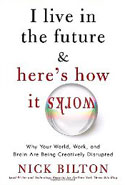
With Graph Expo barely behind us, and as I head off to yet another trade show in yet another venue (this time SGIA in Las Vegas) with my Kindle firmly in tow, I wanted to thank @johnjfoleyjr and @jasonpinto for suggesting a good read. I am well into I Live in the Future and Here's How It Works: Why Your World, Work and Brain are Being Creatively Disrupted, by Nick Bilton, the Lead Technology Writer for The New York Times Bits Blog, and a reporter for the paper. Not only does Bilton document disruptive changes in the way we work, think, are influenced and in turn influence our world over the ages, he takes advantage of the hybrid world of bits and atoms to make the book an interactive experience.
QR Codes in Action
Each chapter begins with a QR Code that allows you to snap an image with your smartphone that will take you to additional relevant content directly from your mobile phone. Apps for the iPhone and iPad are also available. This goes way beyond downloading the book to an eReader and is indicative of a rapidly growing new trend authors are taking advantage of to engage in a dialogue with their readers and make their works interactive and timeless, providing more and different types of information than what can readily be conveyed in a traditional book. Bilton starts by discussing the way his own personal relationship with newspapers has changed, culminating in the cancellation of his free employee subscription to the printed paper because of the ability to more conveniently consume information using all manner of digital communications. And he is still employed there! Although, as he said, his interview on the subject with Wired.com got the "grown ups talking," and not necessarily in a positive way. About the cancellation decision, he says:
I waited until lunchtime to make the call, checking the sea of cubicles around me to make sure nobody could hear me. I felt like a philandering spouse, and the idea of being a cheater didn't feel good.
His rationale was that although the content in the printed version of The New York Times is of the highest quality and well organized, "it's only a collection of what editors think is appropriate … and doesn't swirl in my preferences … it's just not designed for me."
It doesn't take more than a quick peek at the latest newspaper trends to determine that Bilton is not alone, and newspapers are only one small aspect of the disruption he addresses in the book. He talks about today's information consumers being "consumnivores," "collectively rummaging, consuming, distributing, and regurgitating content in byte-size, snack-size and full-meal packages."
No Absolute Formula for Digital Success
Bilton doesn't presume to present a list of absolute formulas for improving the revenue picture in a digital world, saying, "But for those of you wrestling with that challenge (or simply wanting to understand it better), this book will give you a new framework for looking at these difficult issues and making sense of the radical trends that have emerged in the last few years."
And he does just that. Although I might personally have chosen some other area than the porn industry to illustrate the dramatic changes in the way people are consuming content, it is a good example of innovation and entrepreneurialism in action, so to speak, and he chronicles the changes that industry has undergone over the last several decades and how it is capitalizing on today's technologies to not only survive but thrive. He also spends time discussing the many disruptive technologies of the past, ranging from the printing press, to the telephone, radio and TV, ending with "What the future will look like, a prescription for change."
More than 140 Characters
I thought about thanking @johnjfoleyjr and @jasonpinto on Twitter, but I couldn't fit all of this into 140 characters—or even 140 words as a friend of mine once thought was the Twitter limit. I could have put it on Facebook or LinkedIn, but word limits nixed that as well. But I will surely use those media to promote the article once it is published!
The key message is that all these channels need to work together. And whether we like it or not, it is a multitasking world filled with "byte-size, snack-size and full-meal" opportunities.
If you are a printer trying to figure out what the future holds for you, or you are a marketing services provider looking for the next great thing to offer your customers, this book is worth a read. Download it to your Kindle as I did, or buy the printed version and mark it up. Either way, use those QR Codes to get the most out of your investment, and share the wealth with your team. Unlike many business books, it's entertaining while still being informative, thought provoking and educational. And it will give you lots to chew on as you assimilate everything you saw at Graph Expo and are likely to see at SGIA if you choose to attend.
Happy 10th Anniversary
Of course, I can't end this article without mentioning that WhatTheyThink was founded a decade ago and its business model embodies many of the principles Bilton discusses in a real-life success story. There were many naysayers back then, but the crack business and technology team responsible behind the scenes for making WhatTheyThink the success it is today didn't listen to them. Neither should you. Plan carefully and strategically, yes. But push the naysayers to the back burner where they belong.
Here's looking toward the next decade of innovation and entrepreneurialism from the entire WhatTheyThink team, as well as from the survivors and thrivers in our industry. Exciting times ahead!














Discussion
By Gary Lundberg on Oct 12, 2010
Hmmm... should I read it with the Kindle App on by iPad or in Print? Print for this one I think.
thanks,